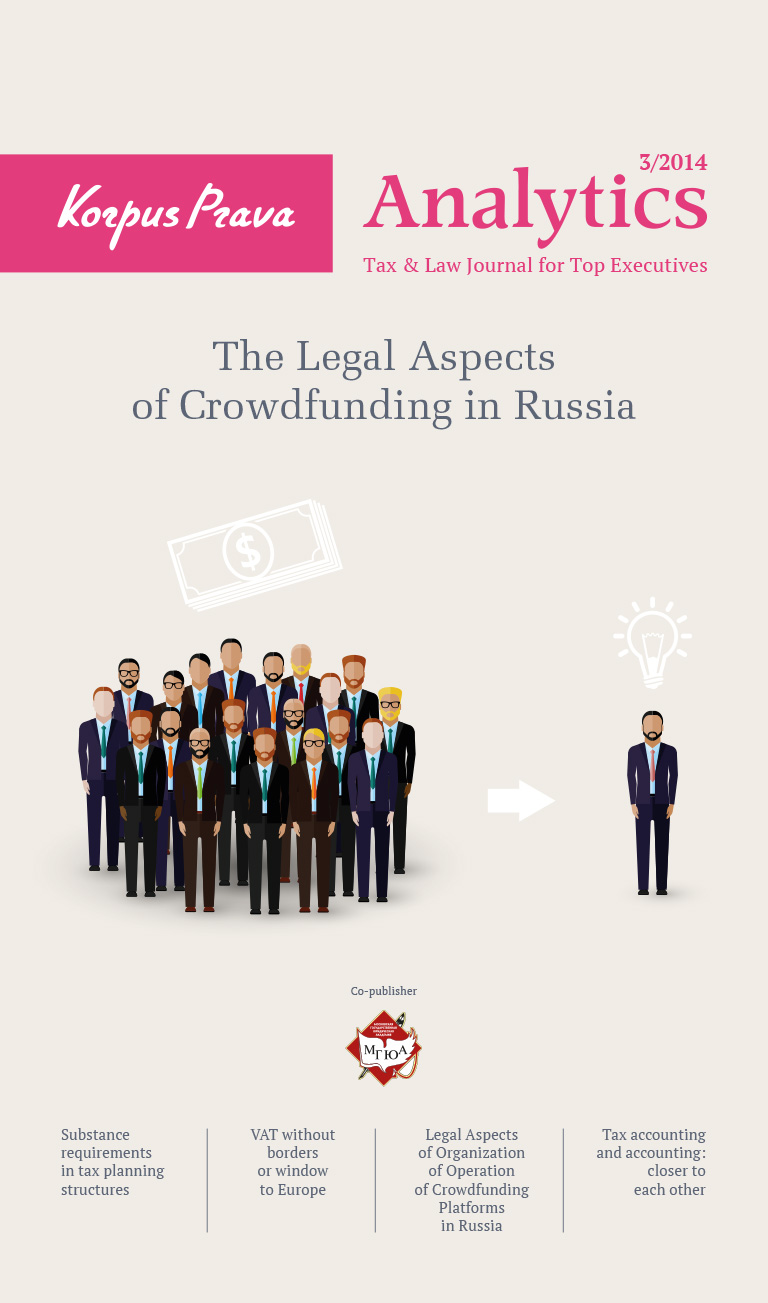- Cyprus Citizenship Scheme for Foreign Investors
- Squeezed But Pleased: Taxation of Passive Income in the European Union
- VAT Without Borders or Window to Europe
- Legal Aspects of Organization of Operation of Crowdfunding Platforms in Russia
- Substance Requirements in Tax Planning Structures
- “Deposit Splitting” of Individuals. Legal Civil and Criminal Aspects
E-money Is a New Cash
In the last two-three decades, innovations in information technology and in financial markets have changed the way economies and financial systems function and the way businesses work. There have been several new and innovative products which have led to developments in electronic commerce and electronic banking. As a result of these developments, we have faced with a new kind of payment instrument, namely electronic money or e-money.
Using electronic money people can make payments more efficient. Transaction costs are lower than in case of using other payment instruments. The amount of e-money transactions have the potential to grow. Widespread use of e-money will probably reduce the use of cash and credit cards. The digitalisation of financial services might boost the use of e-money in near future. Electronic money is a useful find for Internet users and a great assistant in banking transactions and its development potential is enormous. Having in mind that every innovation needs time for implantation, we can expect that in future the world would be covered with e-money.
Electronic money may be in the form of value stored on a technical device such as a chip card or indeed, a computer memory. E-money can be best described as a digital form of cash since it has many of the characteristics of cash.
Customers buy the electronic equivalent of coins and notes. The customer, in effect, has exchanged cash for another means of payment. Instead of using a debit card (which requires a bank account) or a credit card (which requires a contract agreement) the customer has purchased a non-cash means of payment, which can be used in much the same way as cash or other forms of card payment but without the requirement of third party authorization.
E-money can therefore be defined as monetary value as represented by a claim on the issuer, which is:
- Electronically stored;
- Issued on receipt of funds for the purposes of making payment transactions;
- Accepted as means of payment by a natural or legal person other than the issuer.
An Electronic Money Institution (e-money Institution) is an undertaking that has been authorized to issue e-money in accordance with the Regulations referred to below.
The first legislation for issuing of e-money was enacted in 2000, as a European directive for e-money. This directive gave the first definitions of e-money and its characteristics and the legislation for establishment and functioning of the institutions for e-money. The aim of the directive was to create a competition between the banking institutions and the e-money institutions, and at same time to stimulate further innovations in electronic industry. But, despite the established legislation for e-money, the development of this market was very weak and failed to match the initial expectations.
There was a need for change in the e-money legislation. The European commission published in 2009 the new E-money Directive, which implemented the main objectives of the first directive. A new definition of e-money covered the two basic types of e-money: e-money cards and server e-money; the initial capital required for establishing an e-money institution was decreased from 1 million Euros to 350 000 Euros; it increased the number of activities that e-money institution can perform in order to stimulate the competition. Other changes that were introduced with the new Directive were aimed at allowing better access to new and safer services of the electronic market.
Directive 2009/110/EC of the European Parliament and of the Council on the taking up, pursuit and prudential supervision of the business of electronic money institutions was signed on 16 September 2009. Member States had to adopt and publish, not later than 30 April 2011, the laws, regulations and administrative provisions necessary to comply with the Directive.
Electronic Money Institutions (EMI) in the EU are regulated by the EU Directive 2009/110/EC, which has been transposed into the national legislation of Cyprus via Law 81(I) of 2012, whereas the relevant Regulatory and Licensing Authority in Cyprus is the Central Bank of Cyprus. An EMI, once established and duly licensed in Cyprus, may offer its services freely in the EU by setting up branches or on a cross-border basis without any further authorization.
In accordance with the provisions of the Electronic Money Law, electronic money services in the Republic of Cyprus may only be provided by an electronic money institution which has been granted an authorization by the Central Bank of Cyprus (“CBC”). In respect of the general requirements for obtaining the relevant license, an authorization for the operation of an EMI is only granted to a legal person which has been incorporated and has its head office in the Republic of Cyprus. Among the basic criteria for eligibility regarding the submission of an application is a minimum capital requirement of € 350 000,00 at the time of authorization. For the purpose of obtaining an authorization as an EMI, interested persons must submit an application to the CBC accompanied by the information and documents prescribed in paragraph 3 of the Electronic Money Institutions Directive (241/2012) issued by the CBC by virtue of the powers vested in it under the Law.
The Criteria for obtaining an authorization by the CBC are set out in paragraph 3 of Electronic Money Institutions Directive 241/2012 issued by the CBC.
Every application for the authorization of an electronic money institution shall be submitted together with the following:
- A program of operations, setting out in particular the issue of electronic money and the type of any possible payment services envisaged;
- A business plan including a forecast budget calculation for the first three financial years, which demonstrates that the applicant is able to employ the appropriate and proportionate systems, resources and procedures to operate soundly;
- Evidence that the legal person applying for authorization holds the required initial capital;
- A description of the measures taken to ensure compliance with section 13 of the Electronic Money Law of 2012;
- A description of the applicant’s governance arrangements and internal control mechanisms, including administrative, risk management and accounting procedures, which demonstrates that these governance arrangements, control mechanisms and procedures are proportionate, appropriate, sound and adequate;
- A description of the internal control mechanisms which the applicant has established in order to comply with obligations in relation to the Prevention and Suppression of Money Laundering Activities Laws of 2007 and 2010 and Regulation (EC) No 1781/2006 of the European Parliament and of the Council of 15 November 2006 on information on the payer accompanying transfers of funds, as amended or replaced;
- A description of the participation of the applicant in a national or international payment system as well as the intended arrangements for outsourcing of operational activities, the intended use of agents and branches and the intended use of natural or legal persons for the distribution and redemption of electronic money;
- The identity of the persons that have, directly or indirectly, control of the applicant, including the identity of the natural persons that hold, directly or indirectly, shares or voting rights in one or more legal persons that have control of the applicant, as well as details on the size of the actual participation of these persons and their suitability, taking into account the need to ensure the sound and prudent management of an electronic money institution;
- The identity of directors and persons responsible for the management of the electronic money institution and, where relevant, persons responsible for the management of the issue of electronic money and the provision of payment services activities, as well as evidence that they are of good repute and possess appropriate knowledge and experience to issue electronic money and perform payment services, and in particular copy of clean criminal record report, nonbankruptcy report, description of professional and academic qualifications, managerial or board positions held in other legal persons, previous employments and experience in the issue of electronic money and the provision of payment services;
- The identity of statutory auditors;
- The applicant’s legal status and articles of association and
- The address of the applicant’s head office.
E-money is a new payment instrument on the electronic market – it is an innovation. Each of the innovations has its own path from birth to withdrawal from the market. The first and the second phase of their life cycle are followed by the phase of fast development and expansion in the market. There follows the phase with decreasing interest in this innovation, and the cycle is finished with the last phase when innovation leaves the market. The dimension of each of the phases of e-money development cannot be predicted. But we know its life cycle started. That is why we can predict growing expansion of e-money in the future and expect a phase of massive and full use of e-money. With further market penetration of e-money, its influence on monetary policy will become greater. E-money is going to become a very useful payment instrument, so monetary policy of each country will have to face the consequences. Furthermore, monetary policy needs to develop a system of instruments which will be capable of controlling the growing use of e-money and integrate this coming trend into monetary policy fields of interest.
Your subscription to our journal will definitely boost the efficiency of your specialists and downsize your expenses for consultants.
The journal is available free of charge in the electronic version.
Free Download

